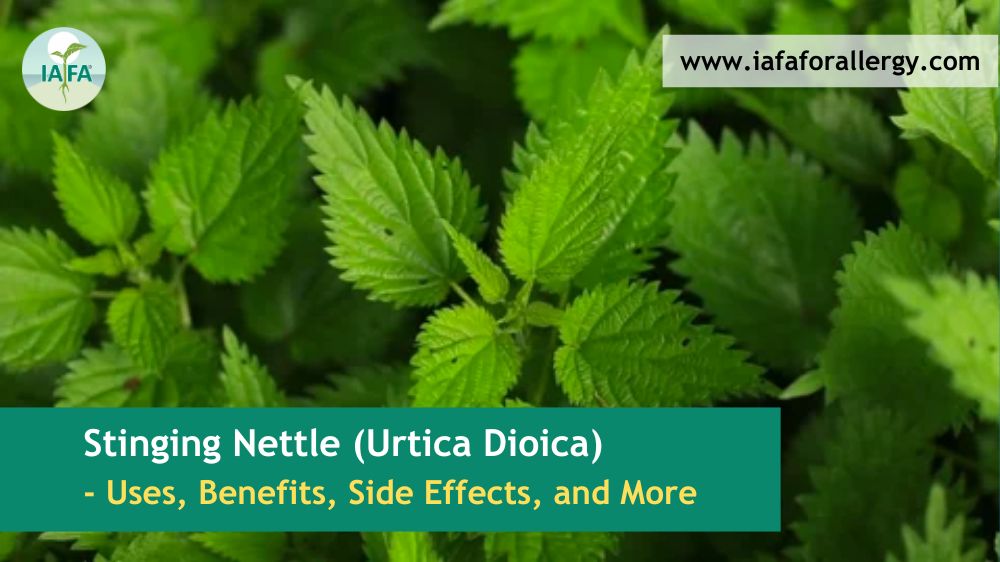A Brief about Stinging Nettle
Stinging nettle is also called Urtica dioica, it can grow in many parts of the world. The leaves of stinging nettle are pointed and contain stinging hairs that can cause rashes if the leaves touch your skin. The word Urtica Dioica is derived from the Latin word, ‘Uro’ meaning “to burn” so make sure while harvesting that it doesn’t touch your skin, otherwise it may cause a burning sensation. Despite stinging hairs, these plants have many benefits as they can be used for medicinal purposes and as a Food source.
Stinging nettle is a herbaceous perennial flowering plant, it is used for medicinal purposes to treat some diseases. In this blog, we are going to cover the uses, benefits, and side effects of stinging nettle, and much more, keep reading.
Uses of Stinging Nettle
There are many uses. We are going to mention the main ones below:-
- Relieve Pain and Inflammation: Stinging Nettle is a Natural pain reliever, it is used for arthritis, muscle pain, and headache. It reduces excessive inflammation in the body and hence can be used to treat many inflammatory diseases like arthritis.
- Boost Immune System: Stinging Nettle contains a good amount of vitamins like vitamins A, C, and K. which help to boost the immune system.
- Maintain Blood Sugar Level (Diabetes): Stinging Nettle seems to maintain sugar levels in blood and animal studies have shown an effect in reducing blood sugar levels and also strengthening heart muscles. It can be used by diabetic patients that can help them to lead a healthy life.
- Relieve from Getting Sick: Stinging nettle tea has anti-microbial, ulcer-preventing, and antibacterial properties that could aid in infection prevention.
- House of Minerals: Stinging nettle is packed with many vitamins, minerals, fatty acids, amino acids, polyphenols, and antioxidants. Some studies have shown that it can increase blood antioxidant levels. As it has many nutrients, consuming it either in the form of supplements or tea can be a great nutrient filler for our bodies.
Benefits of Stinging Nettle
- Stinging Nettle Tea Benefits: It is a herbal made with leaves of stinging nettle leaves. It has a good source of antioxidants and Vitamin A, C, and K help to reduce inflammation, improve prostate health, reduce hay fever symptoms, and control blood sugar level
- Stinging Nettle Root Benefits: stinging nettle roots contain nutrients and compounds like vitamins and minerals, flavonoids, and polyphenols which may help with problems like anaemia, arthritis, and hay fever.
- Allergy Relief: Despite having skin irritation with their leaves, it helps to reduce allergic reactions. So stinging nettle leaves are used for allergies.
- Blood Sugar Control: In diabetics stinging nettle may help lower blood sugar levels. This is perhaps, because it can make people more sensitive to insulin.
- Urinary Diseases: Stinging nettle can be used for the treatment of many urinary tract infections and some studies have shown that it can also be used in the treatment of Benign Prostatic Hyperplasia (BPH).
- Hay Fever: Studies have shown that nettle herbs reduce sneezing and itching in people with hay fever.
Side Effects of Stinging Nettle
- Skin irritation
- Allergic reaction
- Pregnancy and breastfeeding (Stinging nettle not recommended for these people)
- Lowered blood sugar levels
- Digestive issues
How to Use Stinging Nettle?
Stinging nettle is available in various forms and can be consumed either in the form of dried leaves, capsules, creams, ointments, and herbal teas. It’s easily available in the market and you can use it accordingly, use it in the form of cream or ointment for the treatment of rash or consume it in the form of teas and capsules for reducing inflammation and boosting immunity.
Precautions to Use Stinging Nettle:-
- Identify the plant correctly
- Wear gloves while harvesting
- Start With low dose
- Never apply it on an open wound
- Should not be used in pregnant women as it can cause miscarriage
- It can alter the menstrual cycle
- It can interact with other medicines, so make sure you’re not stinging the nettle with other medications
- It can lower blood pressure, so be cautious with your blood pressure
- It can lower blood sugar levels, so it can increase the risk of hypoglycaemia
- Consult health care professionals before using it
A Quick Wrap-Up
Stinging nettle is a potent herb with many uses and benefits. Although leaves of stinging nettle are hairy and stingy and can cause a burning sensation when it comes into contact with our skin, when it is made in the form of supplements, it is safe and is used to treat allergies, reduce inflammation and boost immunity in many people. But precaution should be taken while using it and it is always better to Consult an Ayurvedic Professional before using it.









